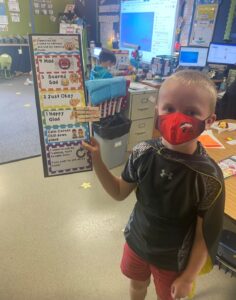Redwood Elementary in Grants Pass, Oregon is one of the schools in our District  Partnerships program. Last school year, the school’s data team collected data about student behaviors that were most challenging to the staff. One of the challenging behaviors was defiance.
Partnerships program. Last school year, the school’s data team collected data about student behaviors that were most challenging to the staff. One of the challenging behaviors was defiance.
Initially, the data team started thinking about it from the teachers’ perspective, wondering what other tools could be used to deal with defiant student behavior. Before the educators implemented any tools, they decided to gather information from students. Teachers talked to students individually and had class discussions. What they learned surprised them! As students shared, a pattern emerged: what the teachers identified as defiant behavior often arose from big feelings. It was an eye-opener that the students and adults had such different perspectives. And it invited the educators to think of a different kind of solution.
Growing Vocabulary and Naming Feelings
The data team proposed to the staff that each classroom teach or reteach lessons in helping students to grow their emotional vocabulary and name their feelings. They also started to include and define feeling words during their schoolwide morning announcements.
Soon something interesting happened. Students started talking about feelings with their teachers, with the adults who supervised the playground, and with the adults who supervised the afternoon pickup.
A Creative Way to Check In about Feelings
Annie Blanchard, a kindergarten teacher, took it a step further in her class. After students began to be able to name their feelings, she created a feelings check-in poster. When students arrived each morning, they moved a clothespin with their name on it to the feeling they were experiencing in the moment.
Students began to be curious about their peers who weren’t feeling good, as indicated on their posters. For example, one morning when a student noticed that another student had put her clip low, he asked Ms. Blanchard why the student wasn’t happy. Together they walked over to check on her. The boy suggested to the girl that when he wasn’t happy, it helped to have someone to play with, and he offered to be that person for her.
The feelings chart was such a hit that at the end of the year, Ms. Blanchard made a chart for each student to take home. They proudly made clips for each person in their home so that they could use it with their families over the summer.



Redwood Elementary kindergartners Tate, Sophia, and Felix show their feelings charts.
Integrating Feelings into Conversations with Families
As the school started this year, staff decided to make space for teachers to have conversations with each family. As part of that conversation, teachers are asking about how families handle big feelings and sharing the work around vocabulary for naming feelings that they did last year in the classrooms.
Redwood Elementary listened to their students and provided opportunities to build their emotional vocabulary. In doing so, they created the opportunity for much better communication with students, educators, and their families. Learning about feelings has been incorporated throughout the school and has made a positive difference in student behavior, which helps create a school community where everyone knows they matter and belong.
Jody McVittie is the Co-Founder and Director of Strategic Partnerships at Sound Discipline
